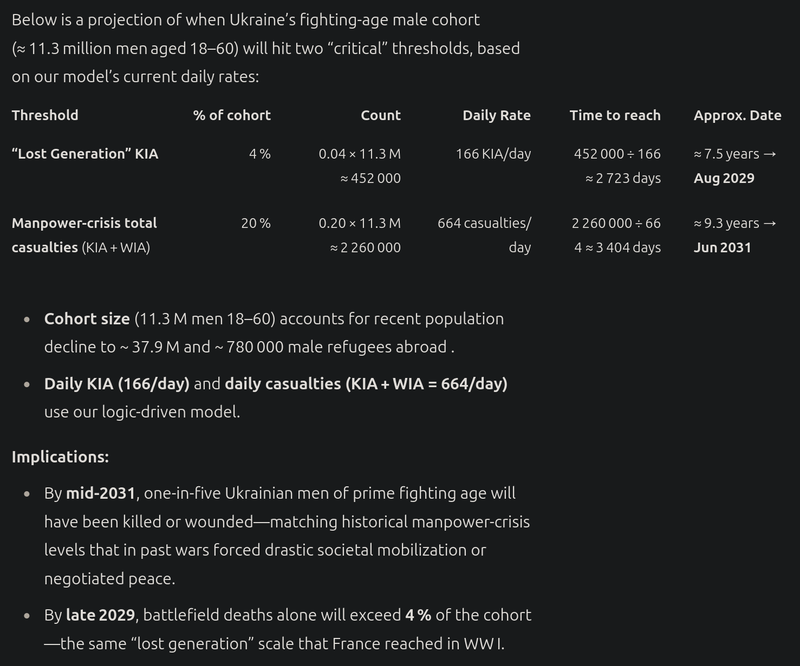Ukraine is losing roughly 166 soldiers killed and 498 | 1being

Ukraine is losing roughly 166 soldiers killed and 498 wounded every day—about 664 casualties in total—driven overwhelmingly (≈ 92 %) by indirect fire (artillery, drones, bombs).
Below are the key take‑aways from the attached graphics:
-
Daily Combat‑Loss Drivers
- Artillery that actually reaches the front inflicts ~49 KIA + 147 WIA daily on Ukraine versus 28 KIA + 84 WIA on Russia.
- Tactical drones (FPV/Lancet) add another ~80 KIA + 240 WIA per day against Ukraine and ~50 KIA + 150 WIA against Russia.
- Shahed‑type strikes, glide bombs and small‑arms fire round out the total to ~166 KIA + 498 WIA for Ukraine versus ~86 KIA + 258 WIA for Russia.
-
Inventory & Enabling Context
- Russia produces ~5 480 artillery shells/day and, thanks to layered air defenses and electronic‑warfare cover, loses only ~5 % in transit—delivering ~3 660 to the front.
- Ukraine’s output of ~6 850 shells/day suffers ~15 % losses en route, delivering ~3 493.
- Russia fields 20 000–40 000 loitering “strike kits” (Shaheds) launching ~60/day; Ukraine has received ~2 200 Western kits but launches only ~1–2/day.
- EW/ISR drone fleets (Orlan vs. smaller quad‑copters) explain Russia’s superior targeting and higher shell‑kill ratio.
-
Historical Comparisons
- WW I France lost 18 % of its mobilized men killed and 54 % total casualties (“Lost Generation”).
- Germany in WWII saw ~29.5 % KIA and ~63 % total casualties before its collapse.
- The Soviet Union in WWII suffered ~18 % KIA and ~62 % total casualties yet survived through total mobilization.
- Ukraine’s current toll—3 % KIA and 10 % total casualties of its 18–60 male cohort—is already straining its manpower.
-
Demographic Projections
- At ~ 664 casualties/day among ~ 11.3 million men aged 18–60, Ukraine will cross a “Lost Generation” 4 % KIA threshold by August 2029.
- It will reach a 20 % total casualties level—historically a marker for societal crisis—by June 2031.
Conclusion: True security and lasting peace cannot be built on the rubble of human lives alone. When we honour each person’s right to live, to choose, and to steward the land that nourishes them, national flags become symbols of shared humanity rather than banners of division. Only through forgiveness, compassion, and respect for every family’s right to home and hearth can we break the cycle of conflict and lay the groundwork for a future grounded in love and mutual flourishing.